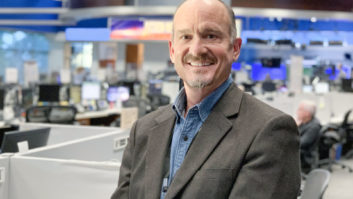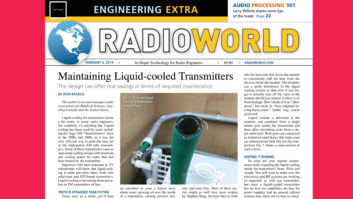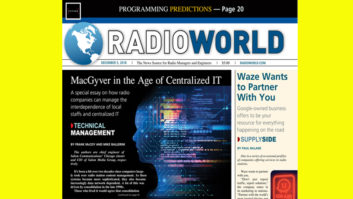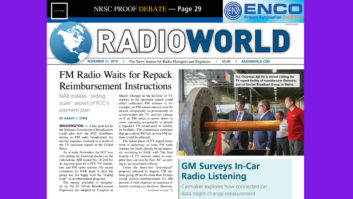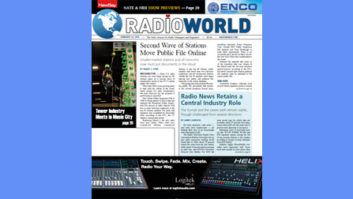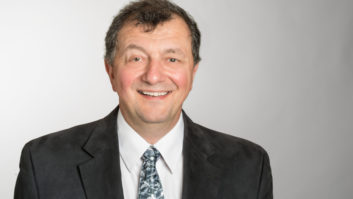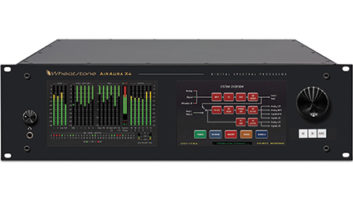This Group of a Few Dozen Technical Experts Helps the Industry Determine Key Issues
The National Radio Systems Committee has been in the news of late; and its members have toiled for years to debate the intricacies of, and test for, a standard for in-band, on-channel digital audio broadcasting in this country.
But this group – mostly technical employees representing companies in the broadcast and receiver industries – does its work with little fanfare and, for the most part, without much recognition. For some in radio, the acronym NRSC may, in fact, mean little. What does the group do? How does it accomplish its tasks?
According to the NRSC Web site, its purpose “is to study and make recommendations for technical standards that relate to radio broadcasting and the reception of radio broadcast signals. The NRSC is a vehicle by which broadcasters and receiver manufacturers can work together towards solutions to common problems in radio broadcast systems.”
Members meet regularly to work on standards including matters of IBOC, AM and other industry issues. The standards it develops are voluntary but influential, essentially recommendations to industry backed by no enforcement power – except that of the market; if a manufacturer builds a broadcast or receiver product to NRSC specifications, it knows the product is compatible with others.
A statement on the committee Web site reads: “NRSC Standards are designed to serve the public interest through eliminating misunderstandings between manufacturers and purchasers, facilitating interchangeability and improvement of products and assisting the purchaser in selecting and obtaining with minimum delay the proper product for his or her particular need.
“Existence of such Standards shall not in any respect preclude any member or nonmember of the CE or the NAB from manufacturing or selling products not conforming to such Standards, nor shall the existence of such Standards preclude their voluntary use by those other than CEA or NAB members, whether the standard is to be used either domestically or internationally.”
The FCC uses the NRSC’s actions as a guideline in setting its own technical rules; the commission is an observer to the group. Some observers believe the NRSC provides technical expertise and research resources that the agency lacks.
The meeting schedule for NRSC and its sub-bodies varies based on topics at hand. Sometimes participants talk every two weeks; at other times, months may pass with no discussion. Meetings are conducted by telephone, or in person at the offices of NAB in Washington and CEA in Northern Virginia and during the annual conventions each organization holds.
The cost of NRSC testing sometimes is shared by the sponsors, as is the case with the current AM tests being conducted by members of that task group, or covered by proponents, as was the case with certain IBOC tests. The matter of who pays is negotiated for each test.
Lively discussions
Participants recall that the NRSC was reconstituted in the mid-1980s to look at AM receiver improvements. The committee had been dormant for many years before that, they said.
Charlie Morgan, who is semi-retired as senior vice president, Susquehanna Radio and is chairman of the NRSC, and John Marino, NAB vice president of science and technology and a staff liaison to the NRSC, said their involvement began when the committee began to look at AM improvement.
Morgan was chairman of the NAB AM Broadcasting Committee. That group realized it needed input from receiver manufacturers. The NRSC reconvened, made up of members of NAB and the Electronic Industries Association, later renamed the Consumer Electronics Association.
The goal, said Morgan, was for “broadcasters and receiver manufacturers to work together in an attempt to either improve or keep AM from further deterioration.”
A member who requested anonymity vividly remembers an early meeting during the CES convention in Chicago. “We met with receivers manufacturers in a shouting match.” But sources agree that today, the atmosphere generally is professional and respectful.
“The real work of the NRSC is done in the task and working group meetings; and the discussion sometimes can become very lively,” said Milford Smith, co-chairman of the DAB Subcommittee and vice president of engineering for Greater Media. “But generally, a collegial mood is preserved.
“No one involved is afraid to speak his or her mind and advance his or her ideas, and that is very much for the best,” said Smith, who has been involved for two decades.
Marino said the group makes decisions by consensus. But behind-the-scenes lobbying and pressure from voting companies apparently come into play as well. That was the case before the NRSC-5 vote, according to sources at the time.
Members typically are companies, associations, engineering consultants and other organizations. The size of the group varies. Attendance at the meeting to approve NRSC-5 was about 70, the largest in recent memory, according to one participant.
Most industry people can attend.
“The NRSC is an open technical committee whereby anyone with a business interest in the technology being studied is welcome to participate,” Marino said.
That, however, does not include journalists. After some inaccurate statements appeared in print in the early days of the NRSC, participants said, the group decided members would feel more comfortable speaking freely if reporters weren’t in the room and possibly misinterpret what was said. It is a position for which the organizers have been criticized by Radio World editors over the years, but one the NRSC shows no signs of altering.
CEA and NAB co-administer the NRSC. “Together, we keep the official records of the NRSC and ensure that the committee follows appropriate open standards-setting procedures,” said Dave Wilson of CEA.
Several participants said NAB and CEA deserve kudos for helping to keep the workflow going smoothly, much as a stage crew does behind the scenes.
Membership in either organization is not a requirement to take part, according to the NRSC Procedures Manual, available at www.nrscstandards.org , although there is a $25 annual membership fee per person per subcommittee for those who are not full members of either trade association.
Many meetings are conducted via phone to keep costs down for the participants. Travel and associated expenses for NRSC member representatives typically are paid by employers. But some participants are said to be so dedicated to the work they have been known to attend “on their own nickel.”
DAB Co-chairman Mike Bergman, who is vice president of new digital technologies for Kenwood USA, said the group could use more receiver manufacturer members.
Process
Much of the major work is done in task and working groups. Their recommendations are passed to a larger group that has voting authority. Once an item reaches a subcommittee, it may be voted on if a quorum is present. A simple majority of subcommittee members typically is needed for passage. In some instances a three-fourths majority is required, for example when adopting a standard.
Standards completed by the group include NRSC-1, -2 and -3, all having to do with improving AM transmission and reception. The FCC made use of NRSC-1 and NRSC-2 when developing Section 73.44 of its rules, Wilson said.
Receiver manufacturers and some broadcasters have implemented NRSC-4, the RDS standard for the United States. An updated version with improved capabilities for artist and song title displays, NRSC-4-A, was approved in the spring.
Hands down, those who commented for this story agreed that the IBOC standard, NRSC-5, was the most important piece of work the group has done recently. They also expect several amendments in the future. The first, incorporating a standard for advanced data services and dubbed NRSC-5-A, was passed during the NAB Radio Show.
NRSC-5 took years to develop. The effort to test and eventually choose one terrestrial digital radio system began in the late 1990s when Digital Radio Express asked the NRSC to reconvene the DAB Subcommittee so the various technologies could be tested.
Evaluating, testing IBOC
Don Messer, recently retired from the International Broadcasting Bureau and now working full-time for Digital Radio Mondiale as chairman of that consortium’s technical committee, was in charge of the evaluation working group of the DAB Subcommittee. Andy Laird, now vice president and chief technology officer of the Journal Broadcast Group, headed the test working groups.
“Before we really got into testing, the merger occurred,” said Messer, referring to the merger of Lucent Digital Radio and USA Digital Radio into what is now Ibiquity Digital. “It made the evaluation process easier – but not the testing – because then we only had to evaluate a single system and compare it to existing AM and FM.”
Bert Goldman, executive vice president with First Broadcasting, has been participating in the NRSC since around 1990. He remembers the group trying to decide whether DAB should be an NRSC function.
NRSC StandardsNRSC-1: NRSC AM Preemphasis/deemphasis and Broadcast Audio Transmission Bandwidth Specifications
NRSC-2: Emission Limitation for AM Broadcast Transmission
NRSC-3: Audio Bandwidth and Distortion Recommendations for AM Broadcast Receivers
NRSC-4: United States RBDS Standard
NRSC-5: IBOC Digital Radio Broadcasting Standard
“We were spurred into action when the Eureka-147 consortium had a display at the Atlanta NAB convention. It became obvious that this technology could dramatically impact broadcasting in the U.S., and as the caretakers for our companies’ assets it would be necessary for us to manage how this new technology developed and impacted our businesses,” he said.
Committee members believe it was vital that they take the time to get the IBOC standard right – even to the point of pausing in their work in May 2003 to tell Ibiquity the group had problems with the performance of the PAC codec at low bit rates on AM.
David Maxson, a partner in Broadcast Signal Lab, said, “I cannot imagine IBOC without an industry consensus standard. If Ibiquity had merely submitted a specification for its system to the FCC, there would have been no input from broadcasters and receiver manufacturers into the specification. … The standard is as thorough and transparent as it is because the NRSC checked out everything it could and required demonstrable proof of performance as well as rigorous documentation.”
The FCC acknowledged the work of the NRSC and how it values those efforts when it released its First Report and Order for IBOC in 2002. Various staffers with the Media Bureau have echoed those views in public panel sessions on digital radio.
There are seven active groups at present. Four meet frequently; they cover the study of AM analog bandwidth, surround sound, multicasting channel ID nomenclature and IBOC standards, according to Bergman. Others include the RDS Subcommittee, the Digital Data Subcommittee and the full NRSC.
In regards to surround, multicasting ID and ancillary data, Morgan said the group could develop a standard but is more likely to issue recommended practices or guidelines.
What to expect from NRSC next? The AM group may soon issue a report on how narrowing transmission bandwidth to 5 kHz or 6 kHz might affect a typical listener’s experience, Wilson said.





